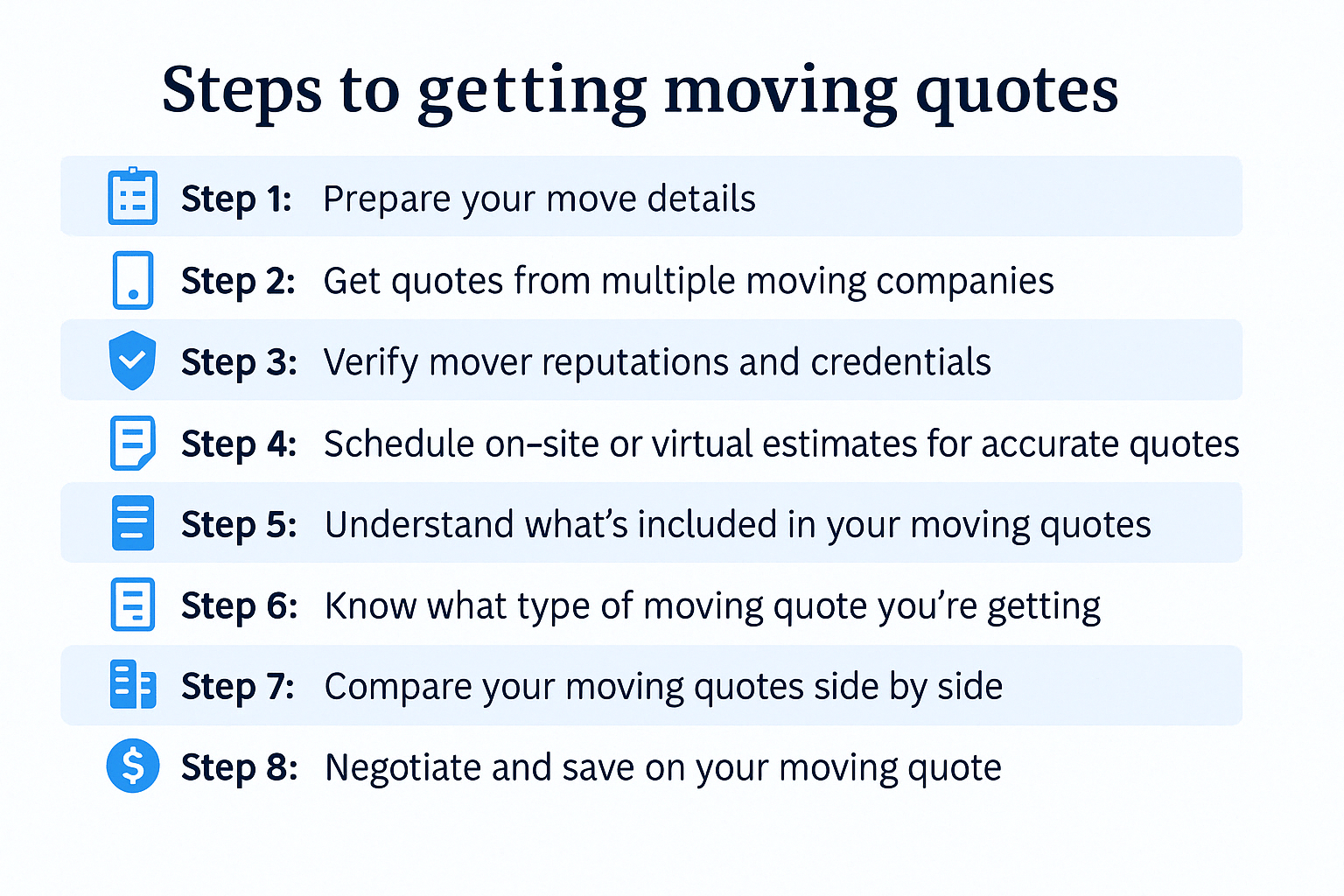Moving Cost Calculator
Use moveBuddha’s free moving cost calculator to estimate how much your move will cost. You’ll get an instant moving estimate without putting in your email or other personal information. Plus, find helpful tips to save on your next move.
Your move is important to us because it’s important to you. We only recommend moving companies that are properly licensed and insured and meet our set of rigorous review standards. Read our full Moving Company Methodology. We take all reasonable measures to protect your personal data and maintain security. Read our Privacy Policy.







Our track record










How Much Do Movers Cost?
The average cost of local moves is around $1,500, while a long-distance move can be $5,000+. These costs vary based on move size, distance, type of move, and time of year. See more details on exact move costs below.
Average cost of local moves
Full-service movers cost about $25–$100 per hour per moving crew member for local moves. A studio or small one-bedroom apartment typically requires two workers and takes two to four hours to complete, with an estimated cost of $455–$1,370. A larger two- to four-bedroom home may take six to 10 hours, require three to five workers, and costs $799–$3,000.
| Home Size | Avg. Total Cost | Cost/hour | # of Movers | # Hours |
|---|---|---|---|---|
| Studio | $340 | $120 | 2 movers | 3 hours |
| 1 Bedroom | $460 | $120 | 2 movers | 4 hours |
| 2 Bedroom | $725 | $170 | 3 movers | 5 hours |
| 3 Bedroom | $1,625 | $235 | 4 movers | 8 hours |
| 4 Bedroom | $1,860 | $235 | 4 movers | 9 hours |
| 5+ Bedroom | $2,850 | $330 | 5 movers | 10 hours |
Average cost of movers by state
Average cost of long-distance moves
Average long-distance costs can range anywhere from $1,000–$14,000+, depending on the size and distance of the move. The best long distance moving companies conduct a virtual or in-home walk-through to provide an accurate binding estimate.
The cost to move a one-bedroom apartment will range anywhere from $1,050 for a few hundred miles to $3,500 or more for a cross-country move. For example, the typical cost of moving a two-bedroom from New York to Florida using a professional moving company ranges from approximately $3,460–$10,500. The cost of moving a two-bedroom 2,900 miles from New York to California using a long-distance moving company will range from $4,400–$13,220.
| Mileage | Studio/1 Bedroom | 2–3 Bedrooms | 4+ Bedrooms |
|---|---|---|---|
| 250–500 miles | $1,380–$3,085 | $2,778–$4,669 | $3,088–$6,545 |
| 1,000 miles | $2,152–$4,643 | $3,244–$5,689 | $3,906–$7,671 |
| 2,500+ miles | $2,425–$4,967 | $4,940–$7,279 | $6,299–$11,266 |
Average cost of DIY moves
If you’re willing to do all the heavy lifting or drive a moving truck, you can usually save yourself a good chunk of change on the total cost of the move. You’ll also have more control over the moving process — especially your moving timeline.
The two main DIY options are moving containers and moving trucks.
- Average moving container cost: The average total cost to move within 50 miles with portable moving container companies is typically around $400–$700 for one container. For local moves, most companies charge a fee every time you move the container. The typical move involves three fees: drop-off, transfer, and pickup. For interstate moves, average moving container costs can range from $900–$4,500 or more.
- Average moving truck rental cost: Rental trucks are the cheapest option for a DIY move. The average price for a local moving truck rental can range anywhere from $30–$500, depending on the size of the truck and duration of the rental. For instance, Budget Truck Rental typically charges $20–$60 per day (plus a per-mile fee) as their base rate to rent a truck for local moves.
Main factors that affect moving costs
Our free moving cost calculator considers the same factors that professional moving companies use to provide a quote, including:
- Move size: Larger moves are more expensive, as they require more labor and a larger moving truck.
- Distance: The greater the distance, the higher your moving quotes will be.
- DIY vs. professional movers: DIY moving services like moving container companies are usually cheaper, but require you to do all the packing and heavy lifting yourself. Professional movers take care of loading, unloading, and transportation, but are much more expensive.
- Time of year: Summer pricing is higher in the moving industry because it’s the peak season for moving companies. The best time to move price-wise is between October and April.
- Moving date: Moving prices tend to be more affordable during the middle of the week and middle of the month. Prices are higher on weekends and at the beginning and end of the month, when most rental lease turnover occurs.
Average moving cost by house size
Additional moving costs & fees to consider
Full-service movers may charge additional fees based on the details of your move:
- Specialty items: Pianos, pool tables, hot tubs, motorcycles, safes, and other bulky items are expensive to move and will increase your overall cost.
- Packing supplies: If a mover has to use moving supplies like bubble wrap, mattress covers, TV boxes, or packing paper, they may charge you. Some moving companies also allow you to purchase packing materials from them directly. Use our packing and moving box calculator to help you estimate how many boxes you will need to start buying for your move.
- Additional services: You can pay a full-service mover for added services such as packing and unpacking and furniture assembly.
- Long-carry, stair-carry, or elevator fees: If the mover can’t park their truck within 100-150 feet of your front door, has to navigate several staircases, or maneuver tricky elevators, they may charge a fee for the extra work.
- Shuttle service: If the moving company has to use a smaller truck to park close to your property, they’ll usually charge a shuttle fee.
- Storage: Most full-service movers offer the option to store your items, and many provide free storage for up to 30 days. For longer-term storage, it’s much cheaper to use a local personal storage facility.
- Extra stops: Need the movers to stop by a local storage unit or your in-laws’ house? Movers will typically charge a fee for additional stops beyond the primary residence.
- Expedited delivery: For an additional cost, movers will expedite your delivery and have your items delivered on or before a specific date.
- Tipping: The amount you should tip movers can vary, but generally speaking, you should tip $20 per person for a half-day move and $40 per person for a full-day, eight-hour move. Check out our movers tipping guide for more recommendations.
How to lower your moving costs
There are a lot of ways to save money when moving. Here are some of our favorites:
- Sell, donate, or trash. The less you move, the less you’ll pay. Take time to consider which items are actually worth moving. Sell, donate, or trash anything that isn’t. This is especially true of heavy items like fitness equipment, old appliances, and book collections.
- Adjust your move date. Moving companies charge more during popular times to move. If you can, avoid moving around holidays or near the end of the month. The summer months can also be 20-30% more expensive, so if you can avoid a summer move, do it.
- Get multiple moving quotes. It’s not unusual for moving estimates to vary by thousands of dollars, especially if you’re moving long-distance. Get at least three moving quotes to ensure you’re getting a fair price.
- Be flexible on pickup & delivery times. Movers often face unexpected delays like weather or traffic issues. Customers with flexible move dates enable moving companies to build some cushion into their schedules, often resulting in a better price.
- Book early. When possible, book your mover 30 to 60 days in advance. Full-service movers may increase prices for last-minute bookings or have limited availability. If you plan on moving during the summer or around a holiday, consider booking 90 days in advance.
- Consider DIY moving services. Full-service moving companies take a lot of the work out of moving, but they’re expensive. Do-it-yourself moving options like rental trucks and moving container companies can be significantly more affordable if you’re willing to do some of the heavy lifting yourself.
- Ask for price matching. The moving industry is competitive, and many companies have a price matching policy to try to win your business. Don’t hesitate to ask for a price match if you’ve found a cheaper quote elsewhere.
- Get free packing supplies. Buying boxes, packing paper, and tape can all add up to hundreds of dollars. However, you can get free moving boxes and other supplies from people who just finished moving. Check out our article on finding free boxes for a lot more options.
- Use your pre-existing insurance coverage. Check with your existing homeowners or renters insurance to see if moving is covered under your policy. If it is, you can avoid spending money on the moving company’s add-on full-valuation coverage.
How to use our moving cost calculator
By following these steps, you can easily plan and budget for your move. You’ll have moving quotes in less than 30 seconds, and since we don’t require any personal information, you won’t be bombarded with follow-up emails or calls.
Here are five simple steps to using our moving cost calculator:
- Select your origin and destination. In the “Where are you moving from?” and “Where are you moving to?” fields, enter the ZIP codes or city names you’re moving to and from.
- Choose your move size. Select the option that best describes the size of your move, from “A few items” up to a “5+ bedroom residence.”
- Pick your moving date. Use the dropdown calendar to lock in your anticipated moving date.
- Review your estimates. Once you enter the details above, the calculator will provide estimates for professional, container, freight, and rental truck moves.
- Compare your options. Review the estimated costs of each moving method, view services, and get quotes from different movers.
How a moving cost calculator can help you
A moving cost calculator is a simple tool that can help you with key moving decisions, from choosing a mover to anticipating costs.
Here’s how a moving cost calculator can help you make your move smarter and less stressful:
- Compare moving methods: See estimated costs for full-service movers, containers, freight trailers, and rental trucks side by side.
- Estimate your budget quickly: Get solid moving quotes in seconds so you know what to expect before reaching out to movers.
- Understand what drives the price: See how factors like the size of your home, the distance of your move, and the services you choose can affect the cost.
- Avoid spam and sales calls: There’s no need to enter personal info to get moving quotes. You can get ballpark estimates here first.
- Choose the best moving company: Not sure which mover fits your situation? Our moving cost calculator can help you compare long distance movers and choose the right one.
- Make informed decisions faster: Get clear estimates without delays so you can start comparing options and planning your move right away.
Steps to get moving quotes

- Prepare your move details. Gather key info like inventory, move dates, locations, and any extra services to get accurate moving quotes.
- Get quotes from multiple moving companies. Compare at least three to five moving quotes to evaluate pricing and service options.
- Verify mover reputations and credentials. Check licensing, insurance, and reviews to avoid scams or poor service.
- Schedule on-site or virtual estimates. A walk-through—either in person or via video—helps ensure an accurate quote.
- Understand what’s included in your moving quotes. Review services, fees, move details, and insurance to avoid surprise charges.
- Know what type of quote you’re getting. Binding, non-binding, and not-to-exceed quotes each come with different rules.
- Compare quotes side by side. Look beyond the price to assess service levels, reputation, and potential red flags.
- Negotiate and look for savings. Ask about discounts, price matching, or other ways to reduce costs like DIY packing.
- Book your move and confirm details. Finalize the contract, pay any deposit, and stay in touch with your mover until moving day.








